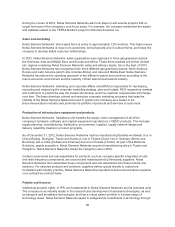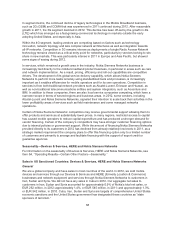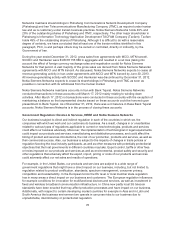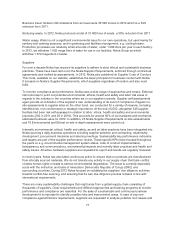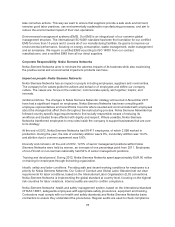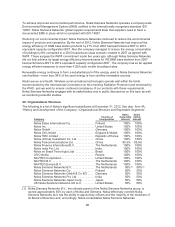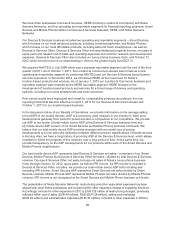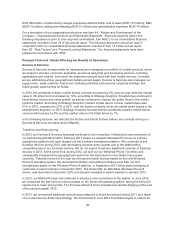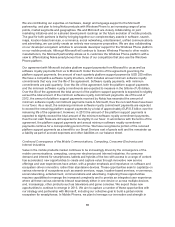Nokia 2012 Annual Report Download - page 77
Download and view the complete annual report
Please find page 77 of the 2012 Nokia annual report below. You can navigate through the pages in the report by either clicking on the pages listed below, or by using the keyword search tool below to find specific information within the annual report.devices are shipped with four or five-star chargers. Although we have moved in lower price points to
more energy efficient chargers we did not fully meet our reduction target for year 2012. The target for
the average no-load was 0.07W and we reached 0.098W which is a reduction of 13% from last year.
The charger no-load power consumption values are calculated as volume weighted average charger
no-load power consumption for phone products per year.
Reporting eco performance of our mobile products. We provide eco declarations or profiles for all our
products, containing some useful information on their environmental impact, materials, energy
efficiency, packaging, disassembly and recycling.
Substance and materials management in our mobile products. Our main objective is to know all the
substances in our products, not just those that raise concerns. Our products must be safe for people
and the environment when used in the proper way. All our mobile devices and accessories worldwide
are fully compliant with the EU Directive on the Restriction of the Use of Certain Hazardous
Substances in Electrical and Electronic Equipment (EU RoHS), and all national requirements of the
same type as RoHS. Our approach is that Nokia’s products do not contain substances included in the
Candidate List of Substances of Very High Concern (SVHC), by the EU Regulation on Registration,
Evaluation, Authorization and Restriction of Chemicals (EU REACH), which the EU REACH regulation
requires to be reported. We evaluate the approach against the new versions of Candidate List of SVHC
and additionally take the notification method into use when necessary. Since 2009, all our new
products must be free of BFR (brominated flame retardants) and RFR (restricted flame retardants), as
defined in the Nokia Substance List (NSL). In case of compliance failures we always clarify and
document the cases and set up corrective and preventive actions. The full NSL, with information about
our substance management, including legal requirements and our voluntary phase-outs, is available on
our website.
Packaging. We continued to improve our packaging, increasing our use of renewable, paper-based
materials to over 95% of total packaging materials. Our packages are 100% recyclable and each part
is individually marked with ISO standard recycle markings. To enable easy recycling, we choose not to
combine plastic and paper materials into single components. For fiber based printing and packaging
materials our aim is to use 100% certified renewable or recycled materials by 2015. We accept
certifications by Forest Stewardship Council (FSC) and The Programme for the Endorsement of Forest
Certification (PEFC), with priority on the former.
Take-back and recycling. Connecting the “next billion” to the Internet and information through our
mobile products is a critical opportunity for Nokia, but also a key concern in the sense that more
products sold means more “e-waste” from old devices as well. We take part in collective recycling
schemes with other equipment manufacturers in Europe, Canada and Australia. We also engage in
local recycling awareness with retailers, operators, other manufacturers, authorities and various local
partners in order to build a recycling culture around the world. Our own take-back and recycling efforts
are thus intended to ensure not only compliance with the European Union Waste Electrical and
Electronic Equipment (WEEE) Directive, but also to ensure we go above and beyond legally set
requirements. Of the materials in a mobile device, 100% can be recovered and used to make new
products or generate energy. Our challenge is now to engage people to make recycling of mobile
products easy and desirable.
Energy efficiency and emissions of our operations. In 2012, our facilities consumed 518 GWh of
energy In total. This energy consumption caused 13 000 tonnes of direct and 224 800 tonnes of
indirect greenhouse gas (C02e) gross emissions. Direct energy means our use of gas and oil, while
indirect energy refers to our use of electricity and district heating/cooling. Nokia Group as a whole
consumed 1 074 GWh of energy. In 2012 our share of renewable electricity was 169 GWh.
76


